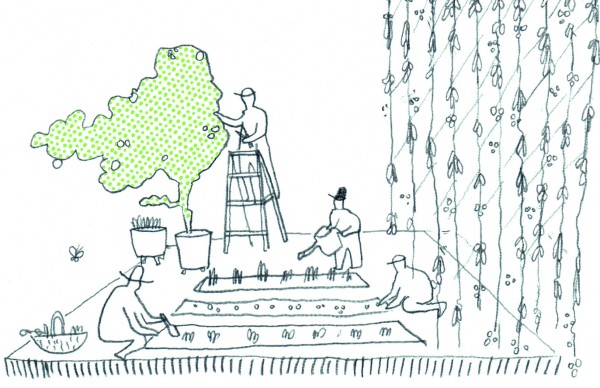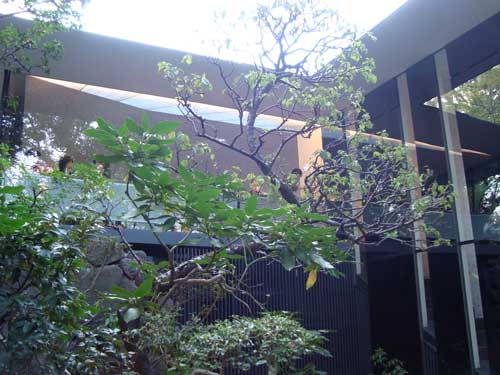
窓が開いています。

There’s something very unknown and exciting in seeing working vessels in a modern harbor. Returning to Tokyo, in the foreground is the Ogasawara Maru’s light fixture. In the center of the frame a tugboat pulls a barge with a giant crane. The vista is wide open, and the sea moving at its own pace.

最初、東京の住民はタヌキさんに「お帰りなさい」の挨拶していません。心を開くことができるでしょうか。
Tokyo residents are over-worked, over-stimulated, and often in their own private worlds. What will it take to inspire our neighbors to welcome tanuki back to his city?

この自宅の入口はすばらしいですね。庭は背が高くて濃いです。
It is amazing that this house and tall garden still exist in Tokyo. I love how thick the garden is, and how open the entrance is to the street.

来週の土曜日の5月19日、SHIBAURA HOUSE の「たべるみどり みるみどり」のキックオフイベントに参加します。子供たちのために種爆弾のワークショップ、グリーンカーテンとグリーン階段の作り方のワークショップ、そして片山陽介さんとトークイベントをします。興味があれば、是非来てください。
Next Saturday, May 19, I’ll be participating at the kick-off of Shibaura House’s two month Eat and See Green program. I am leading a workshop for kids to create seed bombs, helping plant a green curtain and staircase at Shibaura House, and talking on stage with Katayama Yousuke (片山陽介). The events are low-cost and open to the public!

文化の日にオランダ大使館が一般公開されました。大使公邸と庭を訪ねるためにたくさんの人が来ました。東京の中で、たくさんの庭と自然が通常は住民に開かれていません。オランダ大使館の庭は和風と洋風の特徴が混ざっています。よく手に入れされた庭にも、自然に生えたシュロというヤシもあります。シュロというヤシは、江戸時代に多くの用途がありました。オランダ大使館を散歩しながら、長い貿易と鎖国の時代を想像しました。
On Japan’s Culture Day, the Dutch Embassy in Tokyo opened the doors to its magnificent ambassador’s residence and garden. Hundreds of locals took advantage of this rare inside look. It reminded me that many of Tokyo’s greatest green spaces are in private hands or inaccessible to the public like the Imperial Palace.
It’s fantastic that the Netherlands embassy opens their diplomatic outpost to the public twice a year. The house was initially designed in the 1880s and rebuilt after the 1923 earthquake. Although some say the style is “colonial,” the building reminds me of upper class residences in the United State’s northeast. From some angles, I could imagine Gatsby throwing a large garden party.
The garden is a fantastic mix of towering pines and other trees, a pleasantly irregular lawn, and a mix of traditional Japanese garden plants with plenty of imports like roses. Within this well maintained garden, I was pleased to see Tokyo’s native palm tree, the shuro, which easily self-sows and carries a history of being used for centuries in domestic life, as brooms, roofing, and sandals.
The visit also reminded me of the centuries of Dutch-Japanese history. This year I visited Dejima in Nagasaki, the sole foreign trading post during the centuries when Japan remained otherwise closed to the world. The visit conjured scenes of trading ships, cultural emissaries, and globalization in its earlier stages.





Leaving Sinajina bonsai shop in Jiyugaoka, I stopped recently at Okusawa shrine. Jiyugaoka is a very pleasant residential neighborhood, with many free-standing houses and gardens.
This shrine is an incredibly peaceful and magical oasis: mature trees, a beautiful structure, and, apart from the two friends I was with, not a person was visible. It amazes me that beautiful green spaces in Tokyo can be open to the public without guards or attendants, and still remain pristine and inviting.


Diane Durston of the Portland Japanese Garden invited me last week to visit the Nezu Museum, which recently reopened. The art collection of scrolls and screens representing nature from the fourteenth century are stunning, as is the new building designed by Kuma Kengo is a wonderful example of “wafu modern” (和風モダン), a modernization of traditional Japanese design. But mostly I was drawn outside to the large garden.

The winding paths and unexpected size make you feel far from Aoyama. Although just outside the main exhibit hall, the garden is marred by the sight of the strangely tall and also squat Roppongi Hiills Tower, once inside the garden it is a fantasy of forest punctuated by old tea houses, streams and ponds. The garden has been revived yet retains a look of simplicity and wildness. Originally it formed part of the home of the museum founder Nezu Kaichiro, the Tobu Railway president and industrialist who was a collector of pre-modern Japanese and Asian art.
Perhaps even better than Kuma Kengo’s main exhibit hall is his modern take on the Japanese tea house. The new cafe is incredibly light and airy, opening out on to the garden and with an interesting ceiling light that looks like illuminated stone.

Since our visit last Friday, the weather has turned much cooler, especially at night. The next few weeks will have wonderful fall foliage in the garden.
